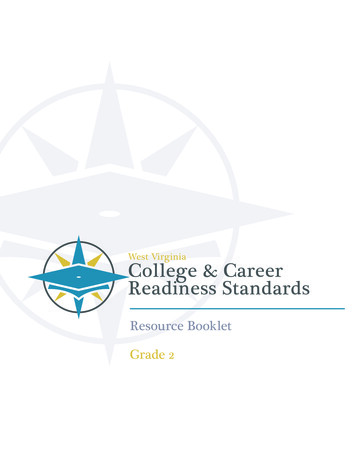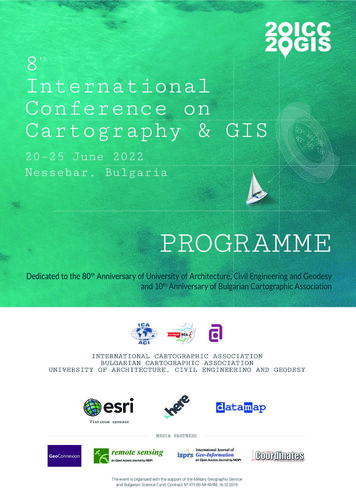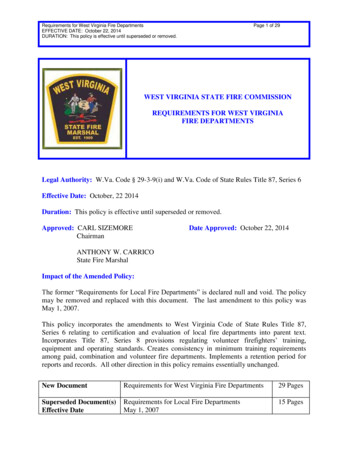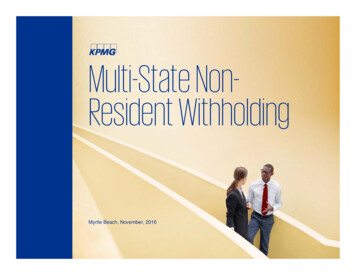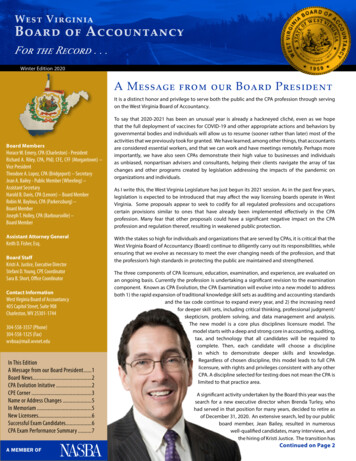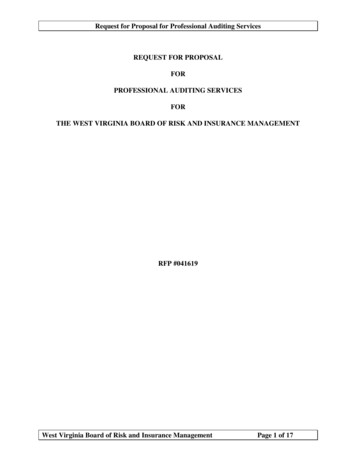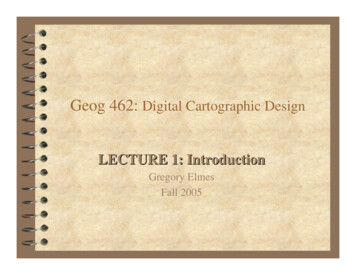
Transcription
Geog 462: Digital Cartographic DesignLECTURE 1: IntroductionGregory ElmesFall 2005
Major Points About the Course CONCEPTS AND PRINCIPLES OF CARTOGRAPHY– Cartography an ancient art and science Long established, long history– Implications of the digital revolution GRAPHICACY – a fundamental skill– Literacy, numeracy– Spatial thinking and reasoning OPPORTUNITY TO LEARN SOFTWARE– Marketable Skills LEARNING TOGETHER– Dr. Elmes is NOT an infinite font of cartographic or digital knowledge!!! Use the resources, especially your fellow students Don’t be bounded by the course outline2
CONCEPTS AND PRINCIPLES OFCARTOGRAPHY Text: Thematic Cartography and Visualization -Terry Slocum– 2nd edition 2004, revised expanded SOME TRUTH WITH MAPS - MacEachren– The Roles of Maps– Cartographic Language– Abstracting Reality– Visualization Quality and the Representation ofUncertainty– Composing the Display3
CONCEPTS IN CARTOGRAPHYCartography is an ancient art:Long historyMulti-culturalMedieval world map –Arabic 1472 ADThe Garden of EdenMedieval cosmology4
The First Known Map?The BedolinaPetroglyph;Valcamonica,Italy,Circa 2500BCEPlan of settlement
A medieval imageof the earth, froman early 15thCenturymanuscriptL'Image du Mondeby Gautier deMetz.What do you noticeabout this image?
What issymbolizedon this map?How is itsymbolized?7
8
Maps are a product of culture,history and science Maps are cultural artifacts, comparable inhistory to arms and amour, musicalinstruments, or ships. Almost all cultures have developed maps, butwith enormously varying degrees ofsophistication and intent. Their origin is instinctive, in that they areproducts of both the intellect and theimagination in confronting problems in reality.For example ?From: Outer Worlds and Inner Worlds: An Introduction to World MapsThe British Library By: Peter Whitfield 2002. MAPS ARE SOCIALLY CONSTRUCTED9
Maps: a product of culture, history andscience Maps face severe practical constraints in their constructionand their use:– Maps have evolved because they were of fundamental importance.– Maps have acquired an aesthetic dimension,– Their forms have been influenced by belief, art, imagination, andsymbolism as well as by empirical knowledge. Cartographers can take account of these interacting forcesand try to analyze the way in which they have shaped theevolving world map. But the history of mapping is not a science: it can describebut not ultimately explainFrom: Outer Worlds and Inner Worlds: An Introduction to World MapsThe British Library By: Peter Whitfield 200210
A dialog between mapmakers andreality The most striking fact of the dialog is that the world map represents areality which, although present to our senses, is perpetually out ofreach. The world map has always been shaped not by science alone, but byreligion, commerce, politics, art, and obsession. Historically, themes such as divine power, the natural elements,secular ambitions, recur constantly and are expressed more often thanpure geography. These influences have been at times conscious, attimes unconscious. Throughout the greater part of history the sourcesof knowledge lay in inherited authority and beliefs, not in reason orexperience, and these sources have left their imprint unmistakably onthe world map. Moreover, the forms in which even scientific knowledge is expressedare constantly evolving, mirroring the societies from which theyspring.11
“Why make a map?” What use is a map?– Do you believe whatyou see on a map?– Do maps lead ormislead?– Do maps unite ordivide? Monmonier “How toLie with tityPrideEducationEtc.12
Computer Cartography Automated Cartography versus Computer AssistedCartography/ Design -what’s the difference? Technological balance– Pens to chips– Particular sets of methods and techniquesappropriate to the technology Analytical emphasis– Theoretical and mathematical underpinnings Rules of map making13
Cartographic Design Principlesfor GIS Three processes common to all maps:– 1. Reduction (scale) National Map Accuracy Standards: on maps 1:20,000, 90% of all locations must bewithin 0.02" (0.5 mm) of actual location.– 2. Selection -- abstraction– 3. Symbolization Communication concepts14
SCALEOrdnance Survey 5 feet tothe mile (1:1056) http://www.bl.uk/collections/map scale.htmlOrdnance Survey 25 inchesto the mile (1:2534)Ordnance Survey 1 inch to the Ordnance Survey 1/4 inchmile.(1:63360)to the mile.(1:253440)Ordnance Survey 6 inches tothe mile (1:10560)World 1:100000015
Selection What to include What to leave out– Conscious decisions– Unconscious decisions Commission Omission16
Some Important Map Elements 1.Title & subtitle 2.Legend– Example of RULES: Forchoropleth maps, do not haveoverlapping values. Forclassification of interval/ratiodata, leave no gaps betweenboxes, for nominal variables,leave gaps. 3. Sources/Credits 4. Scale 5. Direction 6. Coordinate system,including grid reference 7. Graphic Primitives:margins / frame lines, logos, 8. Insets 9.Typography 10.SymbologyFor choropleth maps, increasingdarkness (decreasing color value)with increasing numeric valueKeep same hue & chroma, or use acolor ramp17
The Parts of a Map: Map ElementsBorderNeat lineTitleThe United States of AmericaFigureLegendGroundAlaska0 1 2 3 4Hawaii0 4InsetScaleWashington,D.C.National Capitalhundreds ofkilometers04Place nameLambert Conformal Conic ProjectionSource: U.S. Dept. of StateNorth ArrowCredits18
Important Map Elements Do not consider the preceding as achecklist for what must be on a map, but asa checklist for what to consider.– A part of the selection decisions process There may be other items to consider 19
Communication Concepts Readers’ "flow" through the map consideration ofpurpose & audience– figure to ground– clarity & legibility (e.g. consider size of text and othersymbols for size of map output) Other considerations– page size– explanatory text DESIGN CONCEPT – clearly understood and tothe front of the mind20
http://www.prenhall.com/slocum/21
SUMMARY Cartographic Language Graphic Representation - Abstraction Visualization Displaying Data Communication– AUDIENCE Map Composition Presentation22
The END (of the beginning )– ANY QUESTIONS?23
The most striking fact of the dialog is that the world map represents a reality which, although present to our senses, is perpetually out of reach. The world map has always been shaped not by science alone, but by religion, commerce, politics, art, and obsession.
